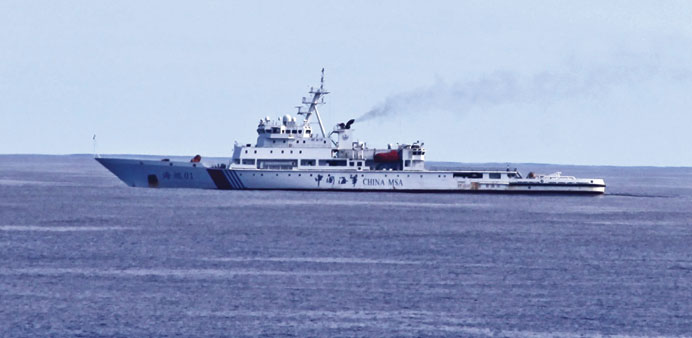AFP/Beijing
A Chinese ship involved in the Indian Ocean search for flight MH370 detected a “pulse signal” at a frequency used by aircraft black boxes yesterday, but Australia warned there was no evidence yet that it was linked to the missing plane.
China’s Xinhua news agency said the signal picked up by a black box detector on the vessel Haixun 01 had a frequency of 37.5kHz — identical to the emergency beacon signal emitted by flight recorders.
Chinese television reporters aboard the ship said crews had briefly detected a similar signal on Friday, but said it was yet to be established whether the sonic pings were from MH370’s black box, whose roughly 30-day locator signal is due to expire soon.
The Malaysia Airlines Boeing 777 vanished March 8 en route from Kuala Lumpur to Beijing, triggering an unprecedented international search across huge expanses of first the South China Sea and now the Indian Ocean.
Australia authorities leading the multinational search in seas far off the country’s west coast advised caution over yesterday’s development.
“The characteristics reported are consistent with the aircraft black box,” retired armed forces chief Angus Houston, head of Australia’s search co-ordination centre, said in a statement.
He added that “a number of white objects were also sighted on the surface about 90 kilometres from the detection area”. “However, there is no confirmation at this stage that the signals and the objects are related to the missing aircraft,” he said.
Australian authorities were seeking more information from the Chinese side and were considering deploying air assets to the detection area, he added.
False hopes, including sightings of suspected debris that turned out to be random flotsam, have repeatedly punctuated the search for the missing plane, keeping the anguished families of the 239 people aboard on an emotional roller-coaster.
“This is not the first time we have had something that has turned out to be very disappointing,” Australian Defence Minister David Johnston cautioned on ABC television.
Malaysian authorities also said they were seeking to verify the report before commenting.
Search teams from eight nations, including Australian and British ships with special detection equipment, are racing against time to find the black box and its vital flight data before the signal fades, hoping it will shed light on the MH370 mystery.
The Haixun 01 picked up the pulse signal at about 25 degrees south latitude and 101 degrees east longitude, Xinhua said. That is about 1,500 kilometres northwest of Perth.
Anish Patel, president of US blackbox beacon manufacturer Dukane Seacom, said he was “highly sceptical” about the report.
“So let’s get some additional assets in the water so we can corroborate, before we get everyone’s hopes up. Before we disappoint these families one more time I think we need to corroborate,” he told CNN.
Nearly a dozen military planes, three civilian jets and 11 ships are currently involved in the protracted search for the Boeing 777, but have so far failed to find any sign of MH370.
Authorities still have no idea how or why the plane vanished, and warn that unless the flight data is recovered, the world may never know.
But Charitha Pattiaratchi, a professor of coastal oceanography at the University of Western Australia, said the news was cause for at least some optimism. “The 37.5 kHz is a man made noise. There’s not another noise at that frequency,” he said, adding this ruled out other possible sources such as whales or undersea seismic activity.
Earlier in Kuala Lumpur, Transport Minister Hishammuddin Hussein said Malaysia would, in line with international agreements, appoint an independent “investigator in charge” to lead an international team to probe what happened to MH370.
The team will include Australia, China, the US, Britain and France. Malaysian authorities believe satellite readings indicate MH370 crashed in the Indian Ocean hours after it veered dramatically off course.
But no proof has been found that would indicate a crash site, and Australian Prime Minister Tony Abbott has described the oceanic search across a huge and undefined area as “the most difficult in human history”.
Several nations that normally do not work together — notably the US and China — have rallied to help look for clues in one of the world’s greatest-ever aviation mysteries.
The Australian naval vessel Ocean Shield, which is carrying a US Navy “black box” detector, and Britain’s HMS Echo, with a similar capability, are searching a 240-kilometre track of ocean in hopes of detecting sonic pings from the recorder.
However, progress is painstaking as vessels must move slowly to improve readings, and officials have acknowledge there is no solid evidence the plane went down in that stretch of sea.

Chinese patrol ship Haixun 01 is pictured during a search for the missing Malaysia Airlines flight MH370, in the southern Indian Ocean yesterday.


